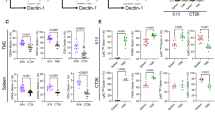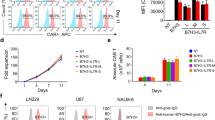Abstract
MHC class I-related chain A (MICA) is one of the major ligands for natural killer group 2 member D (NKG2D), which is an activating NK receptor. MICA is expressed on the surface of human epithelial tumor cells, and its shedding from tumor cells leads to immunosuppression. To activate immune response in the tumor microenvironment, we designed an anti-VEGFR2–MICA bispecific antibody (JZC01), consisting of MICA and an anti-VEGFR2 single chain antibody fragment (JZC00) and explored its potential anti-tumor activity. JZC01 targeted vascular endothelial growth factor receptor 2 (VEGFR2) and inhibited tumorigenesis by blocking the VEGFR2 signaling pathway. Additionally, JZC01 promoted NK and CD8+ T cells to release IFN-γ and engaged activated lymphocytes to lysis of VEGFR2-expressing tumor cells. The in vivo anti-tumor activity of JZC01 was investigated by establishing a Lewis lung cancer cell-transplanted mouse model. It effectively reduced the tumor vascular density and increased the infiltration and activation of NK and CD8+ T cells in the tumor microenvironment. Thus, JZC01 functions in anti-tumor angiogenesis and anti-tumor immune activation, and showed improved anti-tumor efficacy combined with docetaxel, which provides a new insight into anti-tumor therapy.






Similar content being viewed by others
Abbreviations
- JZC00:
-
Anti-VEGFR2 single chain antibody
- JZC01:
-
Anti-VEGFR2–MICA bispecific antibody
- MICA:
-
MHC class I-related chain A
- NKG2D:
-
Natural killer group 2 member D
- NSCLC:
-
Non-small cell lung cancer
- rMICA:
-
Recombined human MICA
- rNKG2D:
-
Recombined human NKG2D
- TIL:
-
Tumor-infiltrating lymphocytes
- VEGF:
-
Vascular endothelial growth factor
- VEGFR2:
-
Vascular endothelial growth factor receptor 2
References
Sharma P, Hu-Lieskovan S, Wargo JA, Ribas A (2017) Primary, adaptive, and acquired resistance to cancer immunotherapy. Cell 168(4):707–723. https://doi.org/10.1016/j.cell.2017.01.017
Waldhauer I, Goehlsdorf D, Gieseke F, Weinschenk T, Wittenbrink M, Ludwig A, Stevanovic S, Rammensee HG, Steinle A (2008) Tumor-associated MICA is shed by ADAM proteases. Can Res 68(15):6368–6376
Raulet DH, Gasser S, Gowen BG, Deng W, Jung H (2013) Regulation of ligands for the NKG2D activating receptor. Annu Rev Immunol 31:413–441. https://doi.org/10.1146/annurev-immunol-032712-095951
Gasser S, Orsulic S, Brown EJ, Raulet DH (2005) The DNA damage pathway regulates innate immune system ligands of the NKG2D receptor. Nature 436(7054):1186–1190. https://doi.org/10.1038/nature03884
Spear P, Wu MR, Sentman ML, Sentman CL (2013) NKG2D ligands as therapeutic targets. Cancer Immun 13(2):8
Groh V, Rhinehart R, Randolph-Habecker J, Topp MS, Riddell SR, Spies T (2001) Costimulation of CD8 alphabeta T cells by NKG2D via engagement by MIC induced on virus-infected cells. Nat Immunol 2(3):255–260. https://doi.org/10.1038/85321
Bauer S, Groh V, Wu J, Steinle A, Phillips JH, Lanier LL, Spies T (1999) Activation of NK cells and T cells by NKG2D, a receptor for stress-inducible MICA. Science 285(5428):727–729
Hu J, Batth IS, Xia X, Li S (2016) Regulation of NKG2D+CD8+ T-cell-mediated antitumor immune surveillance: identification of a novel CD28 activation-mediated, STAT3 phosphorylation-dependent mechanism. Oncoimmunology 5(12):e1252012. https://doi.org/10.1080/2162402X.2016.1252012
Kaiser BK, Yim D, Chow IT, Gonzalez S, Dai Z, Mann HH, Strong RK, Groh V, Spies T (2007) Disulphide-isomerase-enabled shedding of tumour-associated NKG2D ligands. Nature 447(7143):482–486. https://doi.org/10.1038/nature05768
Boutet P, Aguera-Gonzalez S, Atkinson S, Pennington CJ, Edwards DR, Murphy G, Reyburn HT, Vales-Gomez M (2009) Cutting edge: the metalloproteinase ADAM17/TNF-alpha-converting enzyme regulates proteolytic shedding of the MHC class I-related chain B protein. J Immunol 182(1):49–53
Raffaghello L, Prigione I, Airoldi I, Camoriano M, Levreri I, Gambini C, Pende D, Steinle A, Ferrone S, Pistoia V (2004) Downregulation and/or release of NKG2D ligands as immune evasion strategy of human neuroblastoma. Neoplasia 6(5):558–568
Jinushi M, Vanneman M, Munshi NC, Tai YT, Prabhala RH, Ritz J, Neuberg D, Anderson KC, Carrasco DR, Dranoff G (2008) MHC class I chain-related protein A antibodies and shedding are associated with the progression of multiple myeloma. Proc Natl Acad Sci USA 105(4):1285–1290. https://doi.org/10.1073/pnas.0711293105
Holdenrieder S, Stieber P, Peterfi A, Nagel D, Steinle A, Salih HR (2006) Soluble MICA in malignant diseases. Int J Cancer 118(3):684–687. https://doi.org/10.1002/ijc.21382
Huergo-Zapico L, Gonzalez-Rodriguez AP, Contesti J, Gonzalez E, Lopez-Soto A, Fernandez-Guizan A, Acebes-Huerta A, de Los Toyos JR, Lopez-Larrea C, Groh V et al (2012) Expression of ERp5 and GRP78 on the membrane of chronic lymphocytic leukemia cells: association with soluble MICA shedding. Cancer Immunol Immunother 61(8):1201–1210. https://doi.org/10.1007/s00262-011-1195-z
Jia HY, Liu JL, Zhou CJ, Kong F, Yuan MZ, Sun WD, Wang J, Liu L, Zhao JJ, Luan Y (2014) High expression of MICA in human kidney cancer tissue and renal cell carcinoma lines. Asian Pac J Cancer Prev 15(4):1715–1717
Liu Y, Guo X, Xing M, Zhao K, Luo L, Du J (2018) Prognostic value of serum levels of soluble MICA (sMICA) in patients with prostate cancer. Br J Biomed Sci 75(2):98–100. https://doi.org/10.1080/09674845.2017.1402405
Cascone R, Carlucci A, Pierdiluca M, Santini M, Fiorelli A (2017) Prognostic value of soluble major histocompatibility complex class I polypeptide-related sequence A in non-small-cell lung cancer—significance and development. Lung Cancer (Auckl) 8:161–167. https://doi.org/10.2147/LCTT.S105623
Xing S, Zhu Y, Sun Y (2017) Serum smica as biomarker in detection of non-small-cell lung carcinoma. Br J Biomed Sci 2017:1–3
Wang LP, Niu H, Xia YF et al (2015) Prognostic significance of serum sMICA levels in non-small cell lung cancer. Eur Rev Med Pharmacol Sci 19(12):2226
Groh V, Wu J, Yee C, Spies T (2002) Tumour-derived soluble MIC ligands impair expression of NKG2D and T-cell activation. Nature 419(6908):734–738. https://doi.org/10.1038/nature01112
Jayson GC, Kerbel R, Ellis LM, Harris AL (2016) Antiangiogenic therapy in oncology: current status and future directions. Lancet 388(10043):518–529. https://doi.org/10.1016/S0140-6736(15)01088-0
Maishi N, Hida K (2017) Tumor endothelial cells accelerate tumor metastasis. Cancer Sci 108(10):1921–1926. https://doi.org/10.1111/cas.13336
Arnold D, Fuchs CS, Tabernero J, Ohtsu A, Zhu AX, Garon EB, Mackey JR, Paz-Ares L, Baron AD, Okusaka T et al (2017) Meta-analysis of individual patient safety data from six randomized, placebo-controlled trials with the antiangiogenic VEGFR2-binding monoclonal antibody ramucirumab. Ann Oncol 28(12):2932–2942. https://doi.org/10.1093/annonc/mdx514
Sitohy B, Nagy JA, Dvorak HF (2012) Anti-VEGF/VEGFR therapy for cancer: reassessing the target. Cancer Res 72(8):1909–1914. https://doi.org/10.1158/0008-5472.CAN-11-3406
Weis SM, Cheresh DA (2011) Tumor angiogenesis: molecular pathways and therapeutic targets. Nat Med 17(11):1359–1370. https://doi.org/10.1038/nm.2537
Jung K, Heishi T, Khan OF, Kowalski PS, Fukumura D (2017) Ly6Clo monocytes drive immunosuppression and confer resistance to anti-VEGFR2 cancer therapy. J Clin Invest 127(8):3039–3051. https://doi.org/10.1172/JCI93182
Rivera LB, Meyronet D, Hervieu V, Frederick MJ, Bergsland E, Bergers G (2015) Intratumoral myeloid cells regulate responsiveness and resistance to antiangiogenic therapy. Cell Rep 11(4):577–591. https://doi.org/10.1016/j.celrep.2015.03.055
Shrimali RK et al (2010) Antiangiogenic agents can increase lymphocyte infiltration into tumor and enhance the effectiveness of adoptive immunotherapy of cancer. Cancer Res 70:6171–6180
Huang Y, Yuan J, Righi E, Kamoun WS, Ancukiewicz M, Nezivar J, Santosuosso M, Martin JD, Martin MR, Vianello F et al (2012) Vascular normalizing doses of antiangiogenic treatment reprogram the immunosuppressive tumor microenvironment and enhance immunotherapy. Proc Natl Acad Sci USA 109(43):17561–17566. https://doi.org/10.1073/pnas.1215397109
Zhang J, Li H, Wang X, Qi H, Miao X, Zhang T, Chen G, Wang M (2012) Phage-derived fully human antibody scFv fragment directed against human vascular endothelial growth factor receptor 2 blocked its interaction with VEGF. Biotechnol Prog 28(4):981–989. https://doi.org/10.1002/btpr.1559
Xie W, Li D, Zhang J, Li Z, Acheampong DO, He Y, Wang Y, Chen Z, Wang M (2014) Generation and characterization of a novel human IgG1 antibody against vascular endothelial growth factor receptor 2. Cancer Immunol Immunother 63(9):877–888. https://doi.org/10.1007/s00262-014-1560-9
Acheampong DO, Tang M, Wang Y, Zhao X, Xie W, Chen Z et al (2017) A novel fusion antibody exhibits antiangiogenic activity and stimulates NK cell-mediated immune surveillance through fused NKG2D ligand. J Immunother 40(3):94–103. https://doi.org/10.1097/CJI.0000000000000157
Ferrari de Andrade L, Tay RE, Pan D, Luoma AM, Ito Y, Badrinath S, Tsoucas D, Franz B, May KF Jr, Harvey CJ et al (2018) Antibody-mediated inhibition of MICA and MICB shedding promotes NK cell-driven tumor immunity. Science 359(6383):1537–1542. https://doi.org/10.1126/science.aao0505
Wang T, Sun F, Xie W, Tang M, He H, Jia X, Tian X, Wang M, Zhang J (2016) A bispecific protein rG7S-MICA recruits natural killer cells and enhances NKG2D-mediated immunosurveillance against hepatocellular carcinoma. Cancer Lett 372(2):166–178. https://doi.org/10.1016/j.canlet.2016.01.001
Stoufer LK, Davies LD, Culpepper D, McFarland BJ (2009) Rational design of enhanced affinity at the MICA-NKG2D interface (134.51). J Immunol 182:134.151–134.151
Hodi FS, Lawrence D, Lezcano C, Wu X, Zhou J, Sasada T, Zeng W, Giobbie-Hurder A, Atkins MB, Ibrahim N et al (2014) Bevacizumab plus ipilimumab in patients with metastatic melanoma. Cancer Immunol Res 2(7):632–642. https://doi.org/10.1158/2326-6066.CIR-14-0053
Wallin JJ, Bendell JC, Funke R, Sznol M, Korski K, Jones S, Hernandez G, Mier J, He X, Hodi FS et al (2016) Atezolizumab in combination with bevacizumab enhances antigen-specific T-cell migration in metastatic renal cell carcinoma. Nat Commun 7:12624. https://doi.org/10.1038/ncomms12624
Ramjiawan RR, Griffioen AW, Duda DG (2017) Anti-angiogenesis for cancer revisited: is there a role for combinations with immunotherapy? Angiogenesis 20(2):185–204. https://doi.org/10.1007/s10456-017-9552-y
Krebs P, Barnes MJ, Lampe K, Whitley K, Bahjat KS, Beutler B et al (2009) Nk cell-mediated killing of target cells triggers robust antigen-specific T cell-mediated and humoral responses. Blood 113(26):6593–6602
Deng J, Liu X, Rong L, Ni C, Li X, Yang W (2014) Ifnγ-responsiveness of endothelial cells leads to efficient angiostasis in tumours involving down-regulation of dll4. J Pathol 233(2):170–182
Lu Y, Yang W, Qin C, Zhang L, Deng J, Liu S et al (2009) Responsiveness of stromal fibroblasts to ifn-γ blocks tumor growth via angiostasis. J Immunol 183(10):6413–6421
Khan KA, Kerbel RS (2018) Improving immunotherapy outcomes with anti-angiogenic treatments and vice versa. Nat Rev Clin Oncol 15:310–324
Funding
This work was supported in part by the National Natural Science Foundation of China (NSFC 81973223), Natural Science Foundation of Jiangsu Province (BK20161459), Jiangsu Province Qinglan Project (2014); “Double First-Class” University project (CPU2018PZQ12 and CPU2018GY14).
Author information
Authors and Affiliations
Contributions
YX and XZ designed and performed the experiments. YW guided the affinity measurement and cell-based binding assay. MP helped with the NK and CD8+ T cells isolation and IFN-γ detection. JZ, MW, and YW designed the study. YX and JZ wrote the paper.
Corresponding author
Ethics declarations
Conflict of interest
The authors declare that they have no conflict of interest.
Ethical approval and ethical standards
This article does not contain any studies with human participants performed by any of the authors. This study was approved by the Ethics Review Committee of China Pharmaceutical University (9 March 2016). All applicable international, national, and/or institutional guidelines for the care and use of animals were followed. Six-week-old c57BL/6 healthy female mice were purchased from Comparative Medicine Centre of Yangzhou University (Yangzhou, China). All animals were housed in a pathogen-free environment and were treated following the standards of Pharmaceutical Animal Center of China Pharmaceutical University (Approval number XYXK-2016-0011).
Cell line authentication
Murine cancer cell lines, Lewis lung carcinoma (LLC) (CRL-1642, ATCC), and mouse forestomach gastric carcinoma (MFC) (100207, BNCC) were obtained from Shanghai cell bank, Chinese Academy of Sciences. No cell line authentication was necessary since the phenotypes of these cells were checked by Shanghai cell bank before we obtained them and they did not change over time.
Additional information
Publisher's Note
Springer Nature remains neutral with regard to jurisdictional claims in published maps and institutional affiliations.
Electronic supplementary material
Below is the link to the electronic supplementary material.
Rights and permissions
About this article
Cite this article
Xu, Y., Zhang, X., Wang, Y. et al. A VEGFR2–MICA bispecific antibody activates tumor-infiltrating lymphocytes and exhibits potent anti-tumor efficacy in mice. Cancer Immunol Immunother 68, 1429–1441 (2019). https://doi.org/10.1007/s00262-019-02379-9
Received:
Accepted:
Published:
Issue Date:
DOI: https://doi.org/10.1007/s00262-019-02379-9




